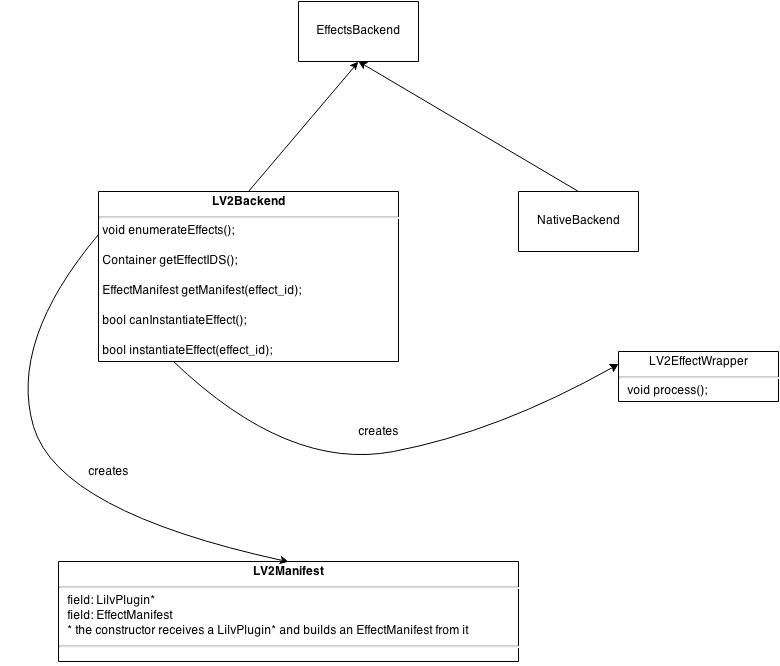-
-
Notifications
You must be signed in to change notification settings - Fork 1.3k
Lv2 Support
Mixxx has now basic LV2 native support. The advantage of native LV2 integration is that every user can benefit from it, it works seamlessly with Mixxx, no tweaks are required to make it functional. The normal user won't see a diference between native effects and LV2 ones. Here is the PR for LV2 support: https://github.com/mixxxdj/mixxx/pull/316
Pending issues (thanks Daniel for the ideas):
- Blacklist: We need to be able to blacklist plugins which are known to be useless for Mixxx like "Stereo to MS"
- We need also an option to hide plugins from the GUI because they will not be used by the DJ (Nicu: isn't this the same as blacklisting a plugin?)
- The same for the Parameters. We need an option to hide unwanted parameter knobs
- We need a "More" popup for plugin with more than 8 useful parameters
- We need a widget that deal with long effect or button names
- The LV2 plugins in preferences should be listed in a list view
- It should contain an "Info" button displaying exactly the info that is displayed by lv2info from the lilv2-utils package
The steps towards basic LV2 integration are the following (I must thank Ryan for his detailed description):
* Create an LV2Backend class which inherits from EffectsBackend
* This backend class is responsible for enumerating (finding) and instantiating effects
* Source files: //src/effects/lv2/lv2backend.[cpp,h]//
* Create a new class which receives an LV2 plugin manifest, parses it and obtains a Mixxx EffectManifest
* This is an important step because Mixxx relies on EffectManifests when creating slots for effects and its parameters
* Source files: //src/effects/lv2/lv2manifest.[cpp,h]//
* Add an LV2 effect wrapper class
* It has to send parameter updates to the plug in instantiation as well as processing audio samples using the plug in.
* Source files: //src/effects/lv2/lv2effectprocessor.[cpp,h]//
* Add a specialized instantiator for LV2 effects. It inherits from ''EffectInstatiator''
* Class name: ''LV2EffectProcessorInstantiator''
* Its responsibility is to pass information to ''LV2EffectProcessor'':
* an //EngineEffect*//
* a //LilvPlugin*//
* two lists with audio and control port indices
* Source file: //src/effects/effectinstantiator.h//
Below is a diagram of the LV2 architecture:

For the first step (parsing the LV2 plugin manifest into an EffectManifest) I used lilv. It is the recommended way for hosts to add LV2 support. Audacity is already using it. Here are some useful lilv functions:
- Create the world which is responsible for plug in discovery
- LilvWorld* lilv_world_new();
- Load all available plug ins
- void lilv_world_load_all(LilvWorld*);
- Get the loaded plug ins
- const LilvPlugins* lilv_world_get_all_plugins(LilvWorld*);
- Iterate through them
- LILV_FOREACH(plugins, iter, container);
- plugins is a keyword, lilv's FOREACH macro takes into account this keyword and knows to call lilv_plugins_* functions
- Get the name of a plugin
- LilvNode* lilv_plugin_get_name(const LilvPlugin*);
- const char* lilv_node_as_string(LilvNode*);
A new tag for buttons used inside the effects framework was introduced,
EffectPushButton. It shall be used by skin developers when they create
a new skin. It supports multi state parameters (LV2 enumeration
parameters) through a multi state button. States can be changed either
by left clicking on the button or by right clicking on it and choosing
an option from the menu. The config key for the newly added button
paramters has the following form:
[EffectRackX_EffectUnitX_EffectX],button_parameterX
The user can run LV2 effects which are using stereo input / output audio samples and don't require any features (examples: kn0ck0ut, Calf Phaser, Calf Flanger, SWH karaoke, etc.). All he has to do is install the desired LV2 plugin.
Here are some features our current implementation supports:
- pop up menu display of available options for enumeration parameters
- LV2 preferences menu
- displays the discovered LV2 plugins
- displays the reason why a plugin is disabled
- lets the user select up to 8 parameters and button parameters to be displayed inside the skin
Mixxx is a free and open-source DJ software.
Manual
Hardware Compatibility
Reporting Bugs
Getting Involved
Contribution Guidelines
Coding Guidelines
Using Git
Developer Guide
Creating Skins
Contributing Mappings
Mixxx Controls
MIDI Scripting
Components JS
HID Scripting
